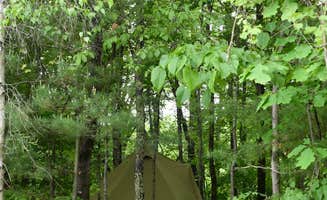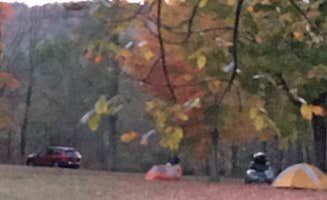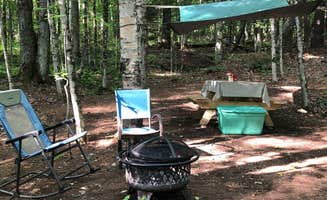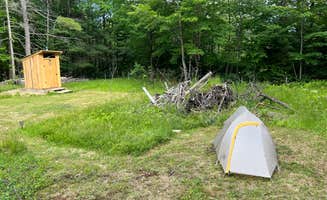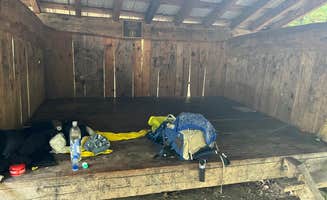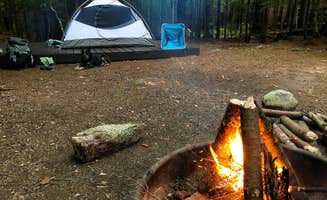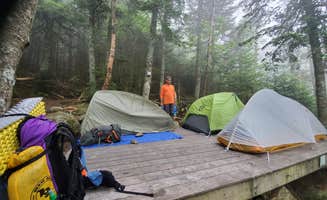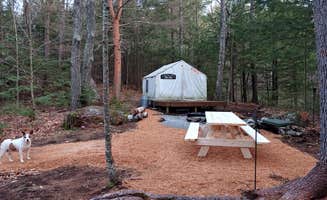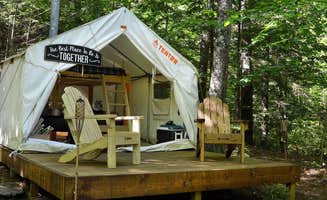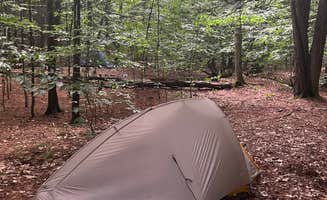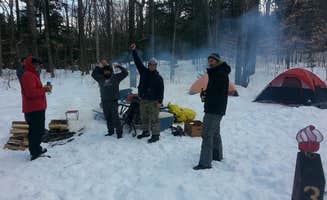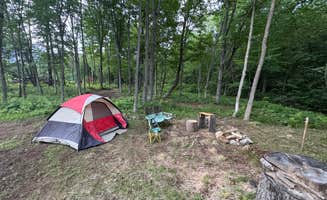Primitive tent camping remains popular near New Hampton, New Hampshire, with sites typically found between 600-2,500 feet elevation throughout the surrounding White Mountain region. Most backcountry areas follow Forest Service regulations requiring camping at least 200 feet from trails and water sources when outside designated sites. Seasonal considerations include mud season limitations from March through early May when many forest roads close, and potential fire restrictions during dry summer months.
What to do
Climb Mt. Cardigan: A challenging but manageable summit hike with fire tower views accessible from Cardigan Campsites. "Great spot to spend the night before a climb of Mt. Cardigan! Or after! The climb is challenging but shouldn't take too long. Great fire tower views at the top too!" reports Madison G.
Ice fishing: Winter visitors can explore frozen ponds when properly equipped. "I've ice-fished on the pond. It's a nice snowshoe hike in winter," notes Jean C. about winter activities at Sawyer Pond.
Paddling: Canoe and kayak enthusiasts can access remote campsites and explore shorelines. At Squam Lakes Association, "excellent kayaking, quiet and serene" provides water-based recreation according to Jen S. Boat-in sites require water transport equipment.
Fly fishing: Several streams and rivers offer trout fishing opportunities through spring, summer and fall. Justin P. mentions, "I tent camped here while doing some fishing in the area," when staying at Baker Rocks near fishing spots.
What campers like
Secluded tent platforms: At Baker Rocks, "the site had a large tent platform they could fit multiple tents, a brand new picnic table, a fire ring (with a free bundle of firewood), two chairs by the fire ring, and even a few strings of solar lights around the camp area," according to Justin P., highlighting the amenities campers appreciate.
Night sky viewing: Star gazing opportunities abound away from light pollution. "The pond is gorgeous and the stars were AMAZING. You do have to forage for firewood, which can be rough, but there's a fire pit right in front of the lean to. I've never seen stars like I did here, all around the pond. They took my breath away!" shares Erin H. about Sawyer Pond.
Shelter options: Many sites offer both tent sites and shelters for flexible accommodations. "The shelter is a standard three-sided shelter. There were a host of large, flat tent sites around the shelter, and I tented in one of these," explains Justin P. about Moose Mountain Backcountry Shelter.
Autumn foliage: Fall brings spectacular colors that attract campers. "Autumn colors across the pond are pretty," notes Jean C. about seasonal appeal at backcountry locations.
What you should know
Water sources: Many backcountry sites lack reliable water access. "There is a water source in the area but it did not have water when I visited (probably on account of the drought)," cautions Justin P. about Trapper John Backcountry Campground.
Site availability: First-come, first-served sites fill quickly during peak periods. Hunter P. explains, "I visited this campsite on a Sunday night in September with my dog and it was lovely. I passed a few day hikers but was the only person camping, however I did speak to a family that was hiking down who said that the campground was completely full the night before (Saturday night)."
Firewood scarcity: At popular sites, gathering firewood can be difficult. "There was very little available firewood near the campsites," warns Hunter P. after camping at Sawyer Pond, while others note illegal tree cutting has damaged some areas.
Road access: Forest Service roads often close seasonally. "The trail head is located at the end of a 9 mile road and there are several spots for parking- note: there is no cell service once you get on this road," advises Hunter P. about access to the best tent camping near New Hampton.
Tips for camping with families
Choose appropriate hikes: Select child-friendly trails for backcountry access. "This is a great beginner backpacking trip, great even for kids!" recommends Sarah C. about Sawyer Pond, adding "We went in from 112 and came out the shorter trail on our last morning."
Arrival timing: Plan to arrive early for walk-in sites, especially with children. "Due to the site's popularity, plan accordingly. Have a back-up plan for an alternate camping location. We witnessed several parties, many with young children, arriving late to find that all the sites were occupied," warns Sarah C.
Field camping: Some sites offer open spaces better suited for families. At Paugus Brook Farm, "The camping area is a field in the back with fairly level ground and lots of space, and is a very short walk from the designated parking area," notes Justin P., making it easier for groups with children.
Wildlife precautions: Teach children proper food storage in bear country. "There is one bear hang located just in front of sites 3 and 4 that is large enough to accommodate food from multiple groups. You will need rope to hang your food, however a cable is provided," explains Sarah C.
Tips from RVers
Climbing-focused sites: RVers interested in rock climbing near New Hampton should consider specific campgrounds. "I started climbing at Rumney about a decade before this campground was developed, and man, were we overdue for one! Maintained by the American Alpine Club, pretty much all the campers here are rock climbers," mentions Les R. about AAC Rattlesnake Campground.
Glamping alternatives: When traditional RV spots are full, consider alternative accommodations. "Our family of 4 visited Baker Rocks during a very rainy week and still had an amazing time. We stayed 2 nights in the double bell tent with two clean full size beds and a 3rd night in the yurt both were spacious and wonderful, among tall trees and pines," shares April W., highlighting options beyond standard tent camping near New Hampton, New Hampshire.


